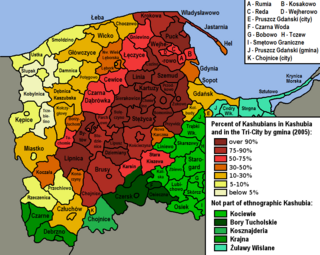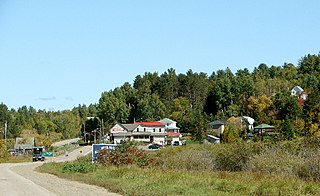
The Kashubians, also known as Cassubians or Kashubs, are a Lechitic ethnic group native to the historical region of Pomerania, including its eastern part called Pomerelia, in north-central Poland. Their settlement area is referred to as Kashubia. They speak the Kashubian language, which is classified as a separate language closely related to Polish.

Kashubian or Cassubian is a West Slavic language belonging to the Lechitic subgroup.

A vampire is a mythical creature that subsists by feeding on the vital essence of the living. In European folklore, vampires are undead humanoid creatures that often visited loved ones and caused mischief or deaths in the neighbourhoods which they inhabited while they were alive. They wore shrouds and were often described as bloated and of ruddy or dark countenance, markedly different from today's gaunt, pale vampire which dates from the early 19th century.

Vampire pumpkins and watermelons are a folk legend from the Balkans, in southeastern Europe, described by ethnologist Tatomir Vukanović. The story is associated with the Romani people of the region, from whom much of traditional vampire folklore originated.
Strigoi in Romanian mythology are troubled spirits that are said to have risen from the grave. They are attributed with the abilities to transform into an animal, become invisible, and to gain vitality from the blood of their victims. Bram Stoker's Dracula may be a modern interpretation of the Strigoi through their historic links with vampirism.
In Balkan folklore, a dhampir is a mythical creature that is the result of a union between a vampire and a human. This union was usually between male vampires and female humans, with stories of female vampires mating with male humans being rare.

Wilno is a settlement in the Township Municipality of Madawaska Valley, Renfrew County, Ontario, Canada.
A psychic vampire is a creature in folklore said to feed off the "life force" of other living creatures. The term can also be used to describe a person who gets increased energy around other people, but leaves those other people exhausted or "drained" of energy. Psychic vampires are represented in the occult beliefs of various cultures and in fiction.
A vrykolakas, is a harmful undead creature in Greek folklore. Similar terms such as vourkolakas (βουρκόλακας), vourvoulakas (βουρβούλακας), vorvolakas (βορβόλακας), vourvolakas (βουρβόλακας), vourdoulakas (βουρδούλακας) were also used for the creature.
A vampire hunter or vampire slayer is a fictional occupation in folklore and fiction which specializes in finding vampires, and sometimes other supernatural creatures. A vampire hunter is usually described as having extensive knowledge of vampires and other monstrous or undead creatures, including their powers and weaknesses, and uses this knowledge to effectively combat them.
A krsnik or kresnik is a type of vampire hunter, a shaman whose spirit wanders from the body in the form of an animal. The krsnik turns into an animal at night to fight off the kudlak, his evil vampire antithesis, with the krsnik appearing as a white animal and the kudlak as a black one. The krsnik's soul leaves the body, either voluntarily or due to a higher power, to fight evil agents and ensure good harvest, health, and happiness.
Jure Grando Alilović or Giure Grando (1578–1656) was a villager from the region of Istria who may have been the first real person described as a vampire in historical records. He was referred to as a štrigon, a local word for something resembling a vampire and a warlock. He was a stonemason, and his wife Ivana bore him two children, Ana and Nikola.

Legends of vampires have existed for millennia; cultures such as the Mesopotamians, Hebrews, ancient Greeks, and Romans had tales of demonic entities and blood-drinking spirits which are considered precursors to modern vampires. Despite the occurrence of vampire-like creatures in these ancient civilizations, the folklore for the entity known today as the vampire originates almost exclusively from early 18th-century Central Europe, particularly Transylvania as verbal traditions of many ethnic groups of the region were recorded and published. In most cases, vampires are revenants of evil beings, suicide victims, or witches, but can also be created by a malevolent spirit possessing a corpse or a living person being bitten by a vampire themselves. Belief in such legends became so rife that in some areas it caused mass hysteria and even public executions of people believed to be vampires.

Aleksander Majkowski was a Polish-Kashubian writer, poet, journalist, editor, activist, and physician. He was the most important figure in the Kashubian movement before World War II, editor of Gryf, author of the greatest Kashubian novel The Life and Adventures of Remus, and Historia Kaszubów.

Sianowo is a village in the administrative district of Gmina Kartuzy, within Kartuzy County, Pomeranian Voivodeship, in northern Poland. It lies approximately 10 kilometres (6 mi) north-west of Kartuzy and 36 km (22 mi) west of the regional capital Gdańsk. It is located on the eastern shore of Sianowskie Lake, within the ethnocultural region of Kashubia in the historic region of Pomerania.
A vjesci is a vampire in Polish folklore. According to legend, some people are born with the destiny of becoming vjesci, discernable by a caul located on the newborn's head. In order to prevent these individuals from becoming a vjesci, the caul was removed, dried, ground and fed to the person on their seventh birthday. Typically, vjesci were said to be indistinguishable from humans, although in some stories, they had a ruddy complexion and an excitable nature. At the time of their death, a vjesci would refuse to take the sacrament. Their body would cool closely, and their limbs would remain limber. Their lips and cheeks would remain red, and spots of blood often appeared under their fingernails and on the face.
The Kashubian diaspora resulted from the emigration of Kashubians mainly in two waves occurring in the second half of the 19th century. The majority of Kashubian emigrants settled in the United States; others emigrated to Canada and Brazil. An online genealogical project, "The Great Kashubian Migration," is devoted to tracking their settlement patterns. Their reasons for emigration varied. Until the Franco-Prussian War, Kashubians emigrated primarily for economic reasons. After the Franco-Prussian War and especially due to the Kulturkampf, Kashubian emigration accelerated as socio-political factors came into play. In his 1899 book, Statystyka ludnosci kaszubskiej, the Kashubophile linguist and sociologist Stefan Ramult estimated that 130,700 Kashubians were living in the Americas.
Marian Jeliński was born in Siemirowice, in 1949. Jeliński is a recognized authority in bee diseases and an active member of the Kashubian community. He is involved in a range of activities focusing on the preservation of the Kashubian language and culture. Jeliński is also known for his support of Kashubian embroidery and building bridges between Kashubian communities in Poland and Canada. He and his wife, Alicja, have two sons and currently live in Żukowo, near Gdańsk, Poland.

Upiór is a demonic being from Slavic and Turkic folklore, a prototype of the vampire. It is suggested that the ubır (upiór) belief spread across the Eurasian steppes through the migrations of the Kipchak-Cuman people, after having its origins in the regions surrounding the Volga (İtil) River and the Pontic steppes. The modern word "vampire" derives from the Old Slavic language and Turkic form онпыр (onpyr), with the addition of the sound "v" before a large nasal vowel (on), characteristic of Old Bulgarian, as evidenced by the traditional Bulgarian form впир (vpir).
Charles Edward Townsend was an American Slavicist and linguist who served as chair of the Department of Slavic Languages and Literatures at Princeton University from 1970 until his 2002 retirement and who authored several well-regarded works on the Russian and Czech languages as well as on Slavic linguistics.








